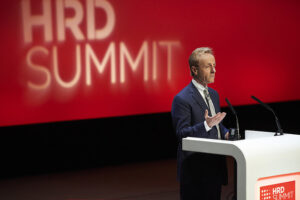Fitting in vs. Belonging at Caffe Nero
- 3 Min Read
Shereen Daniels spoke to delegates at the HRD Summit 2018 about company culture and the idea that ‘fitting in’ and ‘belonging’ are two entirely different paradigms.
- Author: Emily Sexton-Brown
- Date published: Mar 2, 2018
- Categories

How can you ensure that your people feel comfortable within their working environment which allows them to be entirely themselves?
The feeling of belonging
Shereen defined ‘fitting in’ as somewhere you want to be, but others don’t care whether you are there or not. She explained that ‘belonging’ as somewhere you want to be, and others also want you there – quite a difference. “I get to be me if I belong, but I have to be like you to fit in,” she said.
Shereen wants workplace culture to be severely challenged, but at the moment she believes we are just accepting bad attitudes. She asked: “If leaders don’t believe someone ‘fits’ in they should start thinking, ‘how can we help this individual belong?’” She believes this will go a long way to changing the overall culture.
Nothing can diversify without a welcoming culture
Shereen discussed that talent teams are being tasked with finding diverse talent, and are told to scour the earth to find people who are different. She said: “Diversity means nothing if your culture doesn’t make people feel welcome when they get there.
“Most organisations stop at having a diverse organisation at the bottom. Diversity must manifest itself in decision-making all the way up to the top of the organisation.”
Leadership and belonging
For Shereen, leaders should think about what they can do for their team, not what’s in it for them.
Shereen challenges leaders to think about alternative ways to manage and motivate their teams, and urges leaders to:
- Identify your own values and notice if they are apparent throughout your teams
- Question what your own expectations of your team are
- Ask yourself whether your team know that they will have your unwavering support, even if it makes things difficult for you?
- Ask whether your team trusts that you’ll do what you say you’ll do
- Ask whether your team believes that you are genuinely interested in them as people – inside and outside of work.
She also advises that these are the three most important elements when managing others:
- Appreciating and celebrating the diversity of your teams, with a huge emphasis on treating people as individuals
- Accepting people for who and where they are, but refusing to let them stay there. If a person is at point A, your role as a leader is to lead them to point B, C… leaders should leave their teams in a better state than they found them
- Stand for something as a leader and be prepared to publicly defend your position (not necessarily to the media); if you have a have point of view take the opportunity to share it. This must be consistent with what you express inside and outside of work.
She concluded: “Have we forgotten what it feels like to belong? Recognise the person you are.”





